Speech The Global Economic Scene

Malcolm Edey
Assistant Governor (Economic)
Talk to the Australia-Japan Business Outlook Conference 2002
Sydney –
Let me begin by thanking the Japanese Consulate-General and AJEI for the opportunity to speak today on the subject of the global economy.
The year to date has been an eventful one, both for the world economy and for international financial markets. Broadly speaking, it has been a year of gradual recovery after last year's downturn, although recent events have clearly wound back some of the optimism seen a few months ago. In my remarks today, I want to review the key developments this year and focus on current sources of uncertainty concerning the global outlook.
The Situation at the End of 2001
A good place to start is by reviewing the situation as it existed at the end of last year. Clearly, 2001 was a very weak year for the global economy (Table 1).
| Year-ended December Quarter 2001 | March Quarter 2002 | June Quarter 2002 | |
|---|---|---|---|
| United States | 0.1 | 1.2 | 0.3 |
| Germany | 0.0 | 0.2 | 0.3 |
| United Kingdom | 1.5 | 0.1 | 0.9 |
| Japan | −2.0 | 1.4 | |
| Non-Japan Asia* | 0.9 | 1.5 | |
| * GDP weighted, excluding China | |||
We now know that growth in the G-7 economies through the year was negative, the first time it had dipped below zero since the early 1980s. Weak outcomes were recorded in all the major economies:
- The United States was judged by the National Bureau of Economic Research (NBER) to have gone into recession in March last year. That assessment now lines up fairly closely with the recently revised national accounts data, which show US GDP having fallen in each of the first three quarters of last year. In passing, it is interesting to note that the September 11 events did not play a particularly large role in this. Although there were some sharp falls in confidence and spending in the immediate aftermath of those events, the effects proved quite temporary and the US economy was beginning to recover by the end of the year. Even so, growth through the year as a whole was close to zero.
- The Japanese economy recorded negative growth during 2001, and close to its weakest result in the past decade. In broad terms this was a continuation of Japan's disappointing performance of recent years, with ongoing weakness in domestic demand being amplified by the effects of the global downturn.
- Growth in the Euro area last year was only marginally positive, with the slowdown being most pronounced in the largest economies (Germany, France and Italy), while there was stronger growth on the periphery.
- Finally, the non-Japan Asian region was also clearly affected by the international downturn although, as I will draw out later, the region returned to growth more quickly than other parts of the world. China's growth, in contrast to the rest of the region, looks to have been relatively unaffected by the international cycle in the recent period.
In historical terms, how severe was the recent global downturn? I have already mentioned one possible metric for answering that question, namely the growth of the G-7 economies (Graph 1). This shows the early 1980s recession clearly the most severe of the past two decades. The comparison between the two more recent cases is less clear. Last year's drop in growth was somewhat sharper, in aggregate, than the one that occurred in the early 1990s. However, the recessions in Europe and the US last year were both relatively mild. The abruptness of the latest downturn reflected two factors – a closer synchronisation of economic weakness across the major economies last year than was the case in the early 1990s, and also a much sharper downturn in Japan.
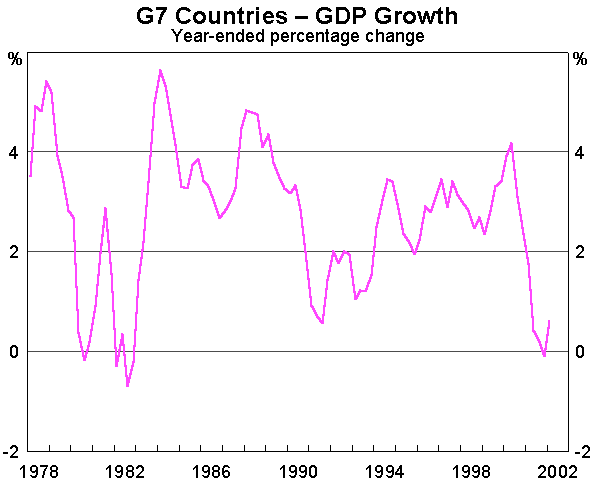
An alternative summary indicator is the estimated growth in the world economy as a whole (Graph 2). On this basis, the most recent downturn was unambiguously milder than its two predecessors. The relative performance in the recent period has been boosted by the increasing weight of fast-growing emerging economies such as China and India[1].
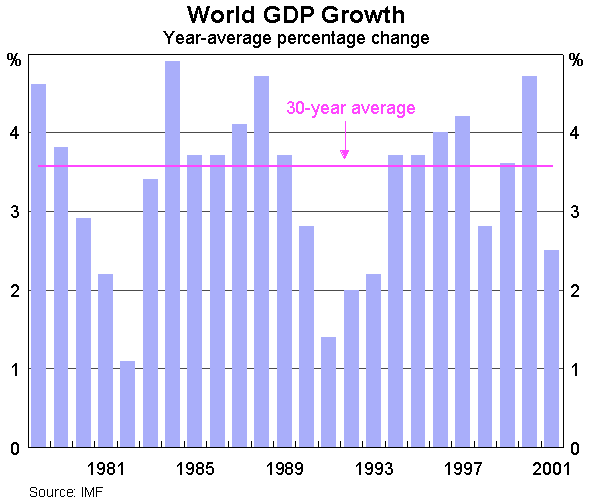
The Global Recovery
Most expectations at the end of last year were that 2002 would be a year of recovery for the major economies, but that the recovery would be a very gradual one. This reflected an assessment that key imbalances in the United States – in particular, low corporate profitability and an overhang of capital spending, especially IT-related spending – would take some time to correct.
While this broadly remained the prevailing view, perceptions of growth prospects did begin to shift quite markedly around the turn of the year. For much of last year, forecasters had been increasingly pessimistic, revising down their expectations of global growth and pushing back the timing of the expected upturn. If we follow the evolution of consensus forecasts month by month, it would indicate that the point of maximum pessimism was reached around the end of the year. The US economy at that time was still expected to grow during the course of 2002, but only modestly, and most people were talking about quite weak outcomes in the near term. In fact, forecasts generally incorporated a further contraction of US GDP in the fourth quarter of 2001.
In the event, information becoming available in the early months of this year indicated that global performance was exceeding expectations, and that in general, a recovery was taking hold earlier than had initially been expected. In this process, considerable attention has been focused on the United States, traditionally regarded as a key driver of the global business cycle.
The US economy returned to growth in the fourth quarter of 2001 and posted strong growth in the first quarter of this year. The latest accounts also show that the expansion continued in the second quarter, even if the pace was disappointingly slow. As is often the case at a cyclical turning point, the inventory cycle played a large initial role in the US upturn, but there were a number of other important contributing factors. Consumer spending in particular has been remarkably resilient to date. Also important has been the expansionary configuration of macroeconomic policies (Graph 3). Interest rates in the US were reduced to historically low levels during 2001, while discretionary tax cuts and government spending increases (along with the automatic stabilisers) have shifted the fiscal position in a markedly expansionary direction. Even though there are undoubtedly some important imbalances still weighing on the US economy, there were promising signs of higher profitability and improving confidence through the first half of this year.
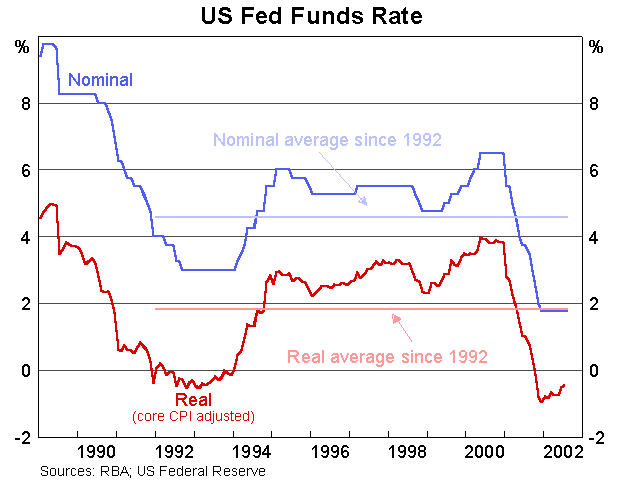
In Japan, too, recent trends have been more positive than expected. Indeed, if we take the national accounts at face value, Japan was the fastest growing of the major economies in the first quarter of this year. Even allowing for some possible overstatement in these figures, there have been a number of reasonably encouraging signs recently. Industrial production in Japan has been on a rising trend since the end of last year, with exports expanding strongly (Graph 4). Business confidence has also begun to improve. Of course, none of this means that Japan's longer-term structural problems have been resolved, and the upturn at this stage remains heavily dependent on continued growth in external demand.
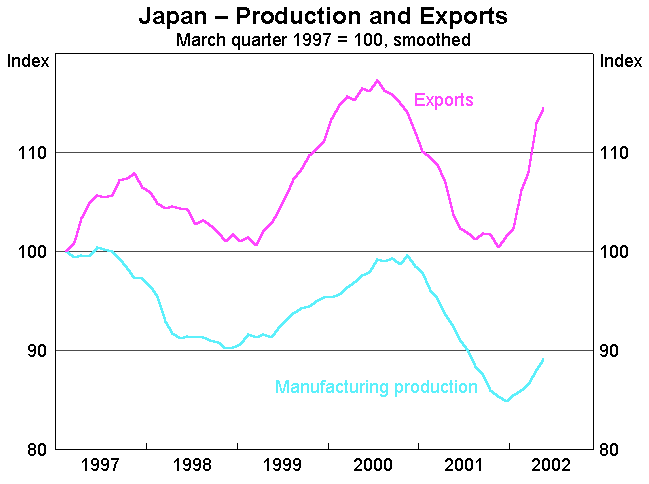
In comparison with Japan, the rest of the east Asian region has experienced a more extended upswing, and one more broadly based across domestic and external demand. It is not always widely appreciated that the timing of the current upswing in non-Japan Asia preceded that in the rest of the world. Excluding China, for which we do not have comparable quarterly accounts, the region in aggregate has recorded positive growth since the September quarter of last year (Graph 5). The figures shown here run only to the March quarter but, on the available evidence, the year-ended growth rate will have picked up further in the June quarter. Domestic consumer spending has contributed importantly to the upturn in a number of countries in the region, along with the recovery in the global electronics industry. The Korean economy has performed particularly well during this period.
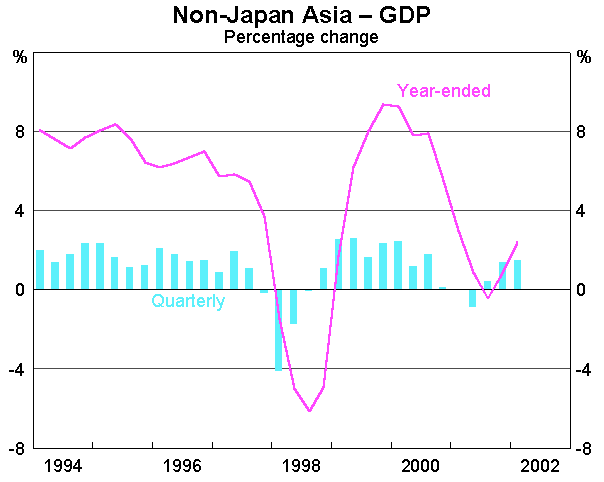
Of the major regions of the global economy, only Europe has been consistently on the disappointing side of expectations so far this year. There were some tentative signs of improved confidence earlier in the year, but so far this has not translated into any significant pickup in growth. Nonetheless, conditions have at least not weakened further since late last year. Available data for the June quarter probably don't change the picture a great deal, showing some small increases in GDP in continental Europe and a somewhat stronger pick-up in the UK.
Clearly, then, there have been some significant disparities in performance this year across the main regions. Nonetheless the general trend for the global economy in the early part of 2002 was one of emerging recovery and increasing optimism.
Recent Developments and Prospects
As I noted at the outset, more recent developments have raised some doubts as to the likely momentum of the global recovery.
One factor that has attracted much attention has been the further recent decline in international equity prices (Graph 6). This was not so much a new development as a further round of weakness after some already substantial falls. The early part of this year had been a period of relative stability in equity markets, coinciding with the more general mood of optimism I have already described. But there was a renewed deterioration in sentiment around the middle of the year. A lot of this was related to disappointing profit results and ongoing corporate scandals in the US, rather than being a reaction to broader economic data. There was also a general recognition that the profit forecasts required to validate existing equity prices were not realistic. Be that as it may, the broad US share market indices have now fallen by around 40 per cent from their March 2000 peak, with similar or larger falls occurring in the other major international markets.
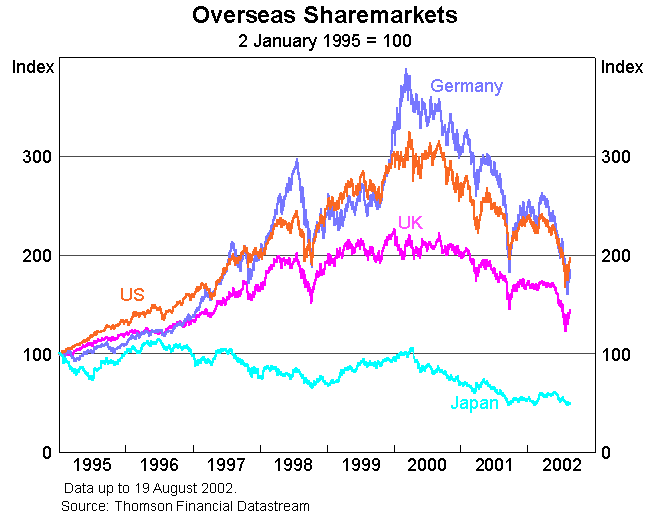
The immediate question raised by a fall in share prices of that sort of order is the size of its impact on global growth. The possible channels for such an impact could be expected to include effects on household wealth, business and consumer confidence, and associated impacts on spending decisions. All of these things are quite difficult at this stage to assess. There are some early signs that business and consumer confidence in the United States have begun to be affected by falling equity prices, but it should be kept in mind that swings in confidence can be quite ephemeral. For example, as I noted earlier, the loss of confidence following the September 11 events proved to be very short lived, and it is quite possible that a period of stability in financial markets would see indicators of confidence picking up again.
In addition to the uncertainties raised by these equity market developments, data on the real economy have also taken on a softer tone in the last couple of months. Of particular note were the second quarter national accounts for the US. Not only did these show that growth in the quarter was disappointingly slow, but revisions to past figures indicated that the recession had been deeper than previously thought. Whether these figures turn out to be an aberration, or whether they represent a more persistent weakening of the trend, remains to be seen. However, they do suggest a somewhat weaker outlook in the near term than had been thought likely a few months ago. Employment growth in the US has also been disappointing. On the other hand, indicators of spending and production are still showing a modest uptrend.
What are we to make of all these developments? It is reasonable to conclude that the widespread optimism seen in the early months of this year was overdone. But this does not mean we have to rush to the other extreme and conclude that the global recovery is stalling. The broad configuration of economic data at present still indicates that the global economy is in a period of gradual expansion. Certainly, the pace of growth has been rather uneven to date, both across countries and through time, but that was also true in the early stages of the previous expansion in the 1990s. In the normal course of events, given the supportive policy settings in place around the world, it would be reasonable to expect that such a recovery would gradually gain momentum and become more broadly based over time. Despite current uncertainties, this remains the most likely outcome.
Endnote
It is possible however that, as a result of data limitations in these countries, the amplitude of their business cycles is understated, which would imply a consequent understatement of the cyclical variation in global GDP. [1]